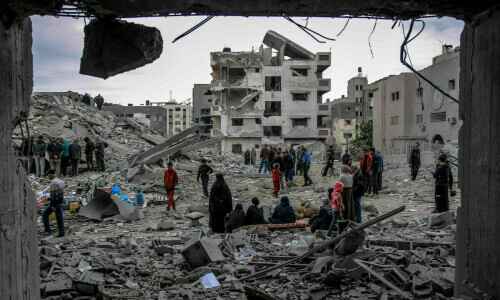GAZA STRIP: The United Nations estimated on Thursday that the rehabilitation of Gaza following the conflict will cost as much as $40 billion and would require an international effort not seen since the end of World conflict II.
It happened as, following weeks of mostly deadlocked discussions, Hamas leader Ismail Haniyeh expressed optimism about a potential peace and hostage release agreement for Gaza.
Nearly seven months into the conflict that has ravaged the Palestinian land, there have been reports of grounds of contention between the militant organization and Israel.
However, in calls to Egyptian and Qatari mediators, Haniyeh, the director of the organization’s political bureau based in Qatar, stated that Hamas was examining the most recent proposal in a “positive spirit”.
The UN calculated that rebuilding Gaza would cost between $30 and $40 billion, with much of the area now reduced to a desolate wasteland of debris.
“The extent of the devastation is enormous and unparalleled… At a briefing in Amman, Jordan, UN assistant secretary-general Abdallah al-Dardari stated, “This is a mission that the global community has not dealt with since World War II.”
“72% of all residential buildings have been completely or partially destroyed,” the UN official stated. The wreckage contains a significant amount of unexploded ordnance, which Gaza’s Civil Defence organization claims sets off “more than 10 explosions every week,” making reconstruction more challenging.
“Complete this”
According to information made public by Britain, mediators have offered a compromise that would put an end to hostilities for 40 days and swap Israeli hostages for thousands of Palestinian detainees.
Israel is still awaiting Hamas’s formal answer to the most recent plan, according to an Israeli official who was not authorized to speak to the media.
Prior to Haniyeh’s remarks on Thursday, it was largely met with disapproval by Hamas officials.
Osama Hamdan, a senior Hamas official, told AFP late on Wednesday that the movement’s stance on the idea was now “negative.”
However, mediators have put tremendous pressure on Hamas to accept the most recent offer. During his most recent Middle East crisis trip, Blinken stated in Israel on Wednesday that “Hamas needs to say yes and needs to get this done.”
Growing disapproval
Israel’s opposition leader, Yair Lapid, claimed after meeting with Blinken that Netanyahu “doesn’t have any political excuse not to move to a deal for the release of the hostages.”
Netanyahu has pledged to send Israeli ground forces into Rafah regardless of whether a truce is achieved, amid US resistance to any operation that does not offer safety to the 1.5 million civilians seeking refuge in Gaza’s southernmost city.
“We will take all necessary measures to defeat our adversary, including in Rafah,” he declared as the cabinet meeting got underway on Thursday.
Atef al-Hout, the head of the emergency department at Nasser Medical Complex in Khan Yunis, the largest city in south Gaza, stated that the department was “almost completely” restored with the assistance of foreign aid and borrowed equipment.
Midway through February, the hospital was the scene of fierce battle that was eventually encircled by Israeli tanks and armored vehicles.
While militants and Israeli troops engaged in combat in Gaza City to the north, witnesses and an AFP correspondent reported airstrikes on Khan Younis on Thursday as well as shelling in the Rafah region.








